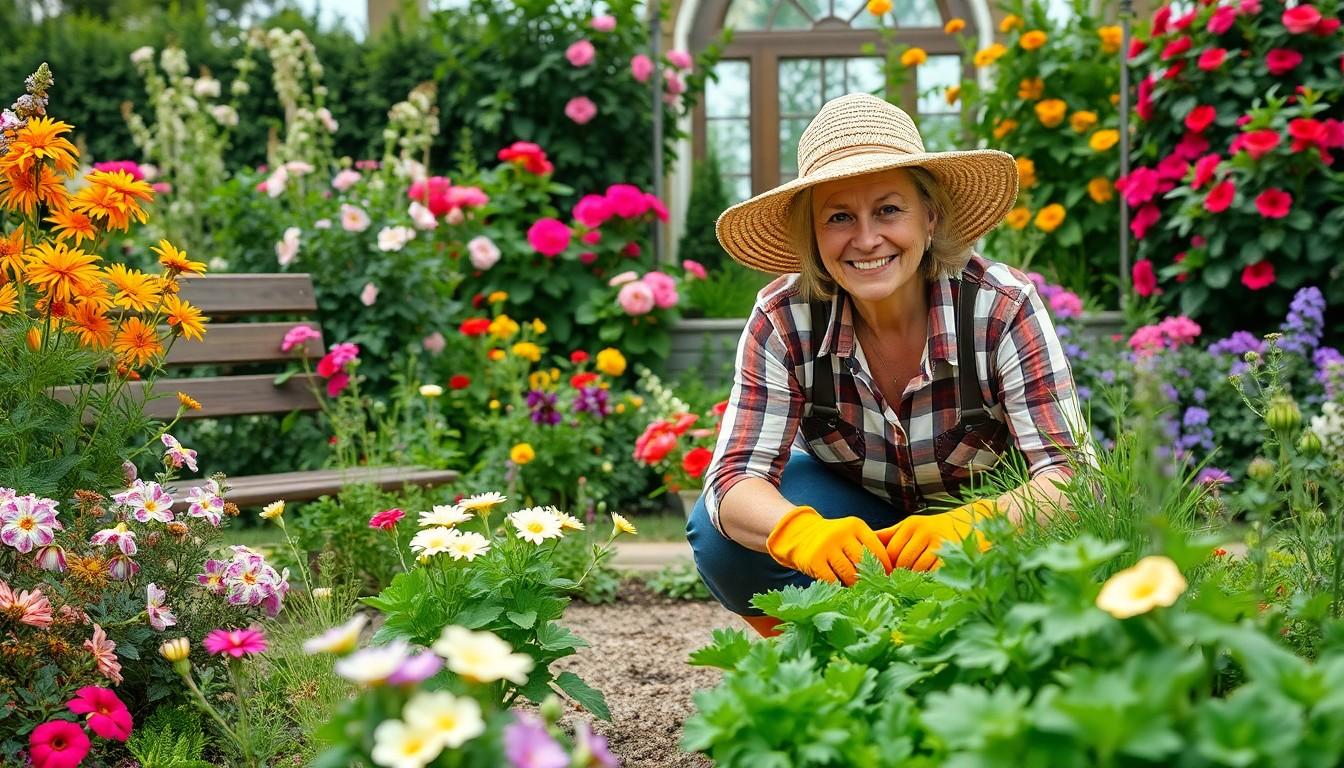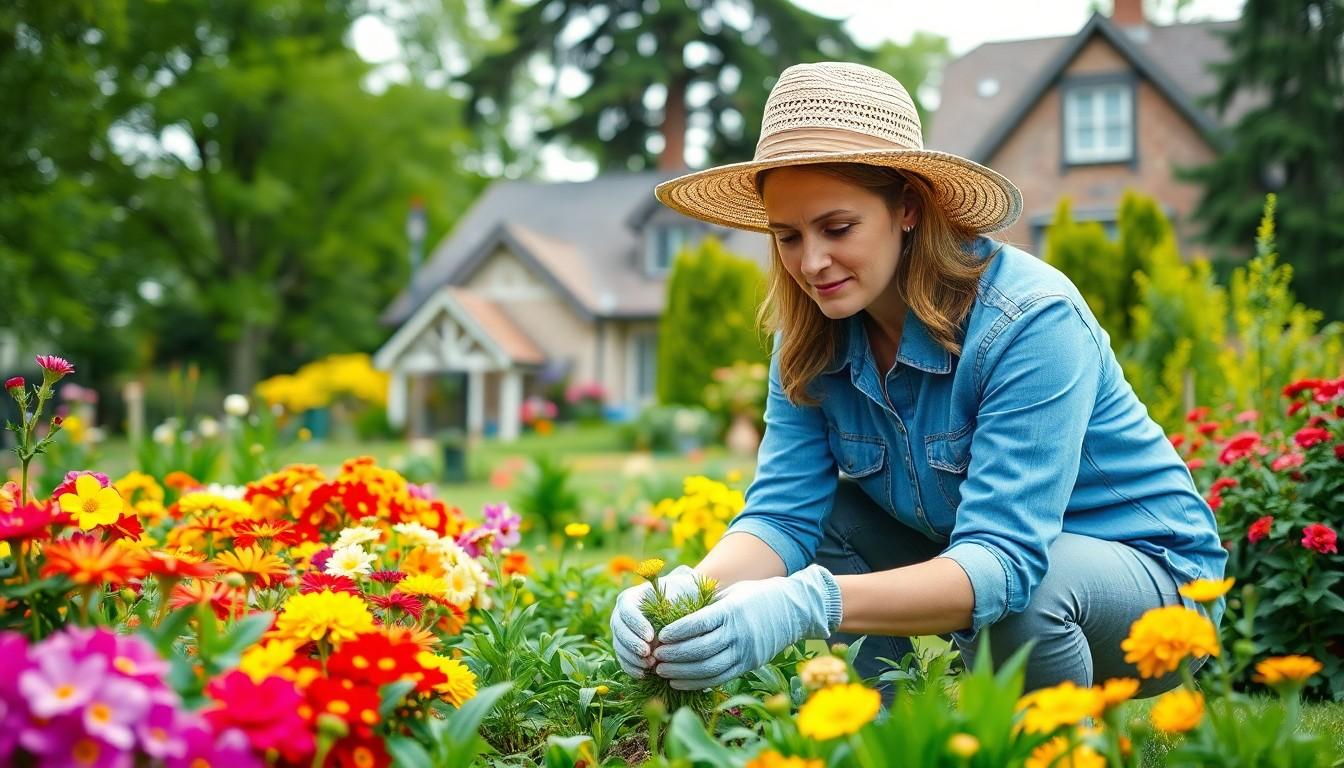Gardening and landscaping aren’t just hobbies; they’re a way to transform ordinary spaces into extraordinary retreats. Imagine stepping into your yard and feeling like you’ve entered a lush paradise, where flowers bloom like confetti and trees stand tall like nature’s bodyguards. With a little creativity and a sprinkle of elbow grease, anyone can turn their outdoor area into a sanctuary that brings joy and relaxation.
Gardening & Landscaping
Gardening and landscaping play crucial roles in enhancing outdoor spaces. Both activities increase property value significantly. A well-maintained garden can elevate a home’s market appeal, making it more attractive to potential buyers. Various studies indicate homes with landscaped yards sell 12% to 14% faster than those without.
Environmental benefits arise from gardening and landscaping. Healthy gardens contribute to improved air quality through oxygen production and pollutant absorption. Trees and plants provide shade, leading to reduced energy costs. Additionally, landscaping helps prevent soil erosion, promoting healthier ecosystems.
Psychological advantages accompany gardening as well. Engaging in gardening promotes relaxation and reduces stress levels. It encourages physical activity, which benefits mental health. Studies reveal that spending time in green spaces boosts happiness and overall well-being.
Community building occurs through landscaping efforts. Neighborhood gardens foster a sense of camaraderie among residents. Participants may connect, share gardening tips, and even collaborate on beautifying communal areas. Such interactions create bonds and enhance community spirit.
Aesthetic value serves as another key aspect of gardening and landscaping. Colorful flowers, varied plant heights, and decorative features add visual appeal. Thoughtfully designed landscapes provide a stunning backdrop for outdoor gatherings.
Sustainability becomes increasingly relevant in gardening practices. Organic gardening eliminates harmful chemicals, promoting more eco-friendly environments. Utilizing native plants encourages biodiversity and supports local wildlife. Implementing water-efficient irrigation systems conserves vital resources.
Gardening and landscaping contribute positively to property values, environmental health, psychological well-being, community engagement, aesthetic charm, and sustainable practices. Each element interconnects to enrich lives and surroundings.
Benefits of Gardening & Landscaping

Gardening and landscaping offer numerous advantages, affecting health, the environment, property values, and community engagement.
Health Benefits
Gardening fosters physical activity, engaging muscles and improving cardiovascular health. Exposure to sunlight boosts vitamin D levels, enhancing mood and promoting overall well-being. Studies show that spending time in gardens reduces stress levels significantly, serving as a therapeutic escape. Mental health improves with regular gardening, as the act fosters mindfulness and relaxation. Furthermore, growing one’s own food encourages healthier eating habits, providing fresh vegetables and fruits directly from the garden.
Environmental Impact
Gardening supports biodiversity by creating habitats for various species, helping preserve ecosystems. Thoughtful landscaping contributes to improved air quality, as plants absorb carbon dioxide and release oxygen. Gardens reduce urban heat through natural shade, potentially lowering energy costs for cooling homes. Soil erosion diminishes with well-planned landscapes that promote healthy root systems. Additionally, native plants thrive with minimal water and care, significantly reducing resource consumption while attracting local wildlife.
Popular Gardening & Landscaping Techniques
Gardening and landscaping techniques enhance outdoor spaces effectively. Two popular methods include organic gardening and xeriscaping.
Organic Gardening
Organic gardening focuses on sustainable practices, promoting health and environmental benefits. This technique avoids synthetic pesticides and fertilizers, opting for natural alternatives that enrich soil and enhance plant growth. Composting serves as a common practice, providing nutrients while reducing waste. Crop rotation is another essential method, preventing pest buildup and improving soil fertility. Various organic plants thrive well in diverse climate zones, allowing gardeners to select species best suited for their locations. Adopting organic gardening leads to healthier produce, significantly reducing exposure to chemicals.
Xeriscaping
Xeriscaping emphasizes water conservation in landscaping, making it ideal for arid regions. This approach utilizes drought-resistant plants that require minimal irrigation once established. Incorporating native species into designs ensures better adaptation to local climates. Designing with mulch protects soil moisture while discouraging weed growth. Use of hardscaping elements, such as rocks and gravel, further reduces water needs while enhancing aesthetics. Communities embracing xeriscaping benefit from lowered water bills and reduced landscape maintenance, promoting sustainable living practices.
Tools and Equipment for Gardening & Landscaping
Understanding the right tools can simplify gardening and landscaping tasks. Different tools serve unique purposes, ensuring efficiency and effectiveness in outdoor projects.
Essential Tools
Hand tools comprise the core of every gardener’s toolkit. Shovels and trowels excel at digging and planting. Pruners and shears simplify the task of trimming branches and shaping plants. Rakes and hoes help maintain soil health and garden aesthetics. Gloves protect hands from thorns and dirt. Wheelbarrows facilitate the transport of materials like soil or mulch. Tools like spades are perfect for edging and creating clean lines in landscapes.
Advanced Equipment
Advanced equipment enhances the efficiency of larger projects. Lawn mowers make maintaining turf simple and straightforward, available in both manual and powered options. Garden tillers break up soil for planting, improving aeration and nutrient access. String trimmers allow for precise trimming along edges and hard-to-reach areas. Leaf blowers save time by quickly clearing debris from walkways and patios. Irrigation systems ensure plants receive consistent moisture, reducing water waste and manual effort. Additionally, garden tractors handle tasks from mowing to plowing, making them versatile companions in extensive landscaping endeavors.
Trends in Gardening & Landscaping
Gardening and landscaping are evolving, driven by sustainability and creativity. These trends reflect a growing awareness of environmental impact and innovative design.
Sustainable Practices
Sustainable gardening emphasizes the importance of eco-friendly methods. Utilizing composting, rainwater collection, and native plants reduces resource consumption. Organic practices avoid harmful pesticides, enhancing soil health and biodiversity. Many gardeners are now incorporating permaculture principles, fostering self-sustaining ecosystems. Communities adopting these methods experience reduced environmental footprints, making these practices increasingly popular.
Vertical Gardening
Vertical gardening redefines traditional gardening approaches, maximizing limited space. Utilizing wall planters, trellises, and stacked containers allows urban dwellers to cultivate plants efficiently. This technique also increases aesthetic appeal, transforming bland walls into vibrant green spaces. Gardeners often choose herbs and ornamental plants, enhancing both cooking and decor. Many communities benefit from vertical gardens by improving air quality and promoting green living.
Gardening and landscaping offer a wealth of benefits that extend beyond mere aesthetics. By transforming outdoor spaces into vibrant retreats, individuals can enhance their property values while promoting environmental sustainability. The mental and physical health advantages of engaging with nature are undeniable, providing a therapeutic escape from daily stressors.
As communities embrace innovative practices and sustainable techniques, they foster connections among neighbors and contribute to a healthier ecosystem. With the right tools and a touch of creativity, anyone can cultivate their own slice of paradise. Whether through organic gardening or vertical gardens, the possibilities are endless for those willing to invest time and effort into their outdoor spaces.

